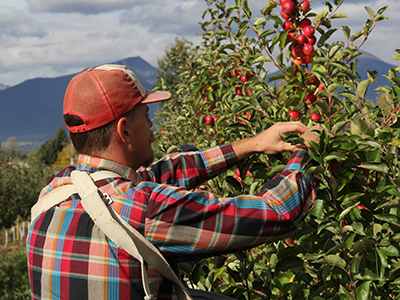Influence of Processing Methods on Elderberry Wine
A website summary of Influences of Processing Methods on Elderberry (Sambucus nigra L.) Wine Quality (https://www.tandfonline.com/doi/full/10.1080/15538362.2024.2442566
by Zhuoyu Wang, Andrej Svyantek, Zachariah Miller*, Aude A. Watrelot, Ashley Kapus (Montana State University)
* Author to whom correspondence should be addressed.
Summary
A study conducted at Montana State University’s Western Agricultural Research Center (MSU WARC) explored how different pre-fermentation processing methods affect the quality of elderberry wine made from the ‘Samyl’ cultivar. Researchers compared boiling, hot water treatment (i.e., blanching), and cold maceration (soaking berries in cold water) on crushed elderberries prior to extracting juice with a press to evaluate their impact on wine color, antioxidant activity, phenolic content, and fermentation chemistry. The processing treatments produced similar levels of ethanol, glycerol, total acidity, volatile acidity and tannins in the finished wines. Antioxidant capacities dropped by about 20% during fermentation. Boiling elderberries prior to fermentation yielded the darkest wine with ~50% higher antioxidant capacity than the other two methods in one of the two antioxidant tests and higher anthocyanin content than the cold maceration.
Introduction
Elderberry (Sambucus nigra) is increasingly recognized for its health benefits, particularly its high antioxidant content and potential antiviral properties. In Montana, interest in elderberry cultivation is growing among producers seeking to diversify with value-added products like wine. Despite elderberry’s popularity, research on optimal winemaking techniques remains limited. This study aimed to fill that gap by evaluating how different processing methods influence the chemical and sensory qualities of elderberry wine. Understanding these effects may help winemakers who want to maximize product quality, safety, and consumer appeal.
Researchers used elderberries from the 'Samyl' cultivar grown at Montana State University's Western Agricultural Research Center in Corvallis. The fruit was frozen after harvest and later thawed and crushed for processing. Three distinct pre-fermentation treatments were applied to evaluate how different methods affect wine quality:
- Hot Water Treatment without Maceration (EC0):
Crushed elderberries were immediately mixed with hot water at 100 °C. This method did not include any maceration period, making it a straightforward approach often used in small-scale elderberry wine production. The mixture was cooled before pressing and fermentation. - Cold Maceration Followed by Hot Water (EC2):
Elderberries were macerated in room-temperature water for two days in a walk-in cooler. This technique is commonly used in grape winemaking to enhance color and flavor compound extraction. After maceration, hot water (100 °C) was added to the must. A non-fermentative yeast strain (Metschnikowia fructicola, marketed as GaïaTM, was added during maceration to reduce spoilage risk. - Boiled Fruit Treatment (EB):
Crushed elderberries were boiled in water for five minutes before fermentation. This method is designed to break down fruit cell walls, enhance pigment and antioxidant extraction, and reduce cyanogenic compounds that can pose safety risks. After boiling, the must was cooled, pressed, and fermented.
All treatments were adjusted to the same sugar level (17 °Brix) and pH (~3.75) using corn sugar and malic acid. Fermentation was carried out using EC-1118 yeast, with nutrient additions and enzyme treatments to support healthy fermentation. Wines were aged for approximately two months before bottling.
Boiling crushed elderberries prior to fermentation produced the darkest wine, with the highest concentration of anthocyanins and increased antioxidant capacity by ~50% over the other two treatments. Cold maceration resulted in lighter-colored wine and lower antioxidant levels.
All three treatments yielded wines with similar alcohol content (just under 10%), glycerol levels, and acidity. EB wines had slightly lower pH, which may improve microbial stability and shelf life. Tannin levels were consistent across treatments, contributing to mouthfeel and astringency.
In terms of phenolic compounds, EB wines had the highest anthocyanin content, while cold maceration (EC2) wines showed slightly higher levels of hydroxycinnamates—compounds linked to flavor and antioxidant properties. Flavanols and flavonols were similar across all treatments, indicating that brief exposure to high temperatures (boiling) did not degrade these compounds.
Elderberries, like apples and cherries, contain trace cyanide-producing compounds. These are concentrated in stems and unripe berries but are minimal in ripe berries—lower than in apple seeds and comparable to pressed apple juice. Processing steps like boiling can reduce these compounds, though not always entirely. This study did not assess how pre-fermentation treatments affect cyanogenic levels in the final wines.
Conclusion
Boiling elderberries before fermentation is the most effective method for maximizing wine color and antioxidant content and should reduce the already low levels of cyanogenic compounds in the fruit. Cold maceration may enhance certain flavor precursors but does not improve antioxidant yield. Hot water treatment offers a simpler alternative with moderate results. These findings support the development of high-quality elderberry wines and encourage further exploration of fermentation techniques to enhance product appeal.
Funding Acknowledgement
The work was supported by the Montana Department of Agriculture Specialty Crop Block Grant, Grant No. AM22SCBPMT1127.

